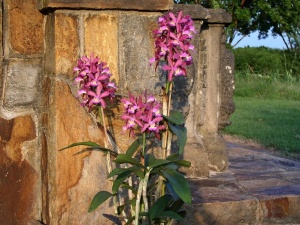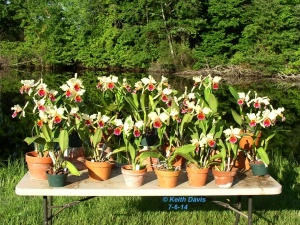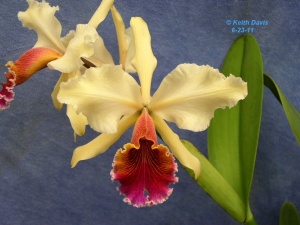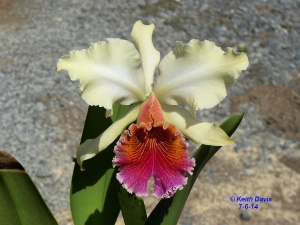Cattleya Hybrids
C. Ave Maria 'White Cloud'
(C. Bob Betts x C. Esther Kennedy)This cross was registered in 1955 by an old orchid nursery called Toy Orchids located in California. My friend, R.E.Post, obtained a seedling of this and it bloomed out to be this fine white with these elegant classic features. His wife, Willistene, painted it and I show a photograph of her stunning artistic skills.
C. Bob Betts 'Sestina' FCC/AOS
C. Bow Bells x C. mossiae)This is one of two FCC awards to the grex (C. mossiae x Bow Bells). There are at least 70 AOS awards to this cross. Mr. P. G. Barnett obtained the whole plant in flower from Stewarts. He showed it in Los Angeles, CA on 2-13-67 and it received an AM of 84 points. Then 11 days later, he showed it (or another plant) at the Miami International Orchid Show where it received an FCC of 90 points. He actually purchased a first class seat on the airline for the plant when he flew to Miami. Mr. Barnett received many AOS awards and was a very good grower and is famous for all the FCC and other awards he got.
C. Hybrida (1859)
(C. guttata x C. loddigesii)C. Hybrida is a name used for more than one hybrid, so to designate the correct one we are covering, the date it was first registered is given. C. Hybrida (1859) was registered by Veitch yet it was not until 1968 that the first AOS award was granted to this hybrid between C. guttata and C. loddigesii.
The cross has been remade many times and also sibling crosses have been made. Unfortunately, many hybridizers in the past did not differentiate between C. guttata and C. leopoldii (tigrina), so it is almost certain that some remakes of C. Hybrida were with true guttata and perhaps more of them were remade with C. leopoldii since it is usually darker, larger and better shaped.
Things get complicated from here as there is no way to really know which was used, but most likely almost all of the ones available today used C. leopoldii as one parent rather than guttata. Technically, leopoldii X loddigesii is registered as C. Gaudii (1897 by Maron). Officially, I can find only one offspring listed and no AOS awards or any photographs. This is an injustice to the hybrid since almost assuredly most things listed as C. Hybrida (1859) are in fact C. Gaudii.
Most plants of C. Hybrida are of light to darker lavender colors with some spotting. If alba parents are used, then the offspring will be white or greenish. The loddigesii parent often dominates in the lip shape and gives the hybrid better shape. Flower count is usually higher than loddigesii since guttata or leopoldii can have over 20 blooms per spike. Blooming usually coincides with the guttata/leopoldii timing (summer) rather than the loddigesii parent (late winter/early spring).
The clone 'Michael' AM/AOS shown is quite short compared to most. This was a result of a remake using the species whereas the 'Hackneau' AM/AOS clone is a result of a sib cross and the plant is almost twice as tall as 'Michael' although the blooms are very similar.
C. Nigrella 'AM/RHS'
C. Fabia (1894) x C. Ypres (1918))This cross was registered in 1934 by Sanders of England. This orchid firm registered 2163 hybrids between 1881 and 1963. It is one of the most important breeders of its time in producing dark flowers. There have been nearly 2000 hybrids created with it. Amazingly, it is comprised of only 3 species, dowiana (50%), labiata, and loddigesii. Most dark, large flowered hybrids have Nigrella in the background. This clone received an AM award from the Royal Horticulture Society (RHS) and was simply given the clone name of 'AM/RHS'. Another famous clone is called 'Jungle Princess'.
C. Triumphans
(C. dowiana aurea x C. rex 'Imperial')This cross, C.rex x C. dowiana, was originally registered in 1904 by Maron and has been remade numerous times. The clones shown here are all from a remake done at the Orchid Trail Greenhouses in North Carolina. A superior clone of C. rex was used that was called 'Imperial' and came from Stewarts. The other parent was a clear yellow dowiana (aurea) from Columbia. This cross resulted in exceptionally high quality with large blooms, good segment color and finely colored lips. Plants are larger than either parent, super vigorous and exhibit what breeders call "hybrid vigor". The first clone shown for AOS judging earned an AM/AOS award. I suspect that more awards will be forthcoming from this beautiful primary hybrid. It should earn an award just for the fragrance!












